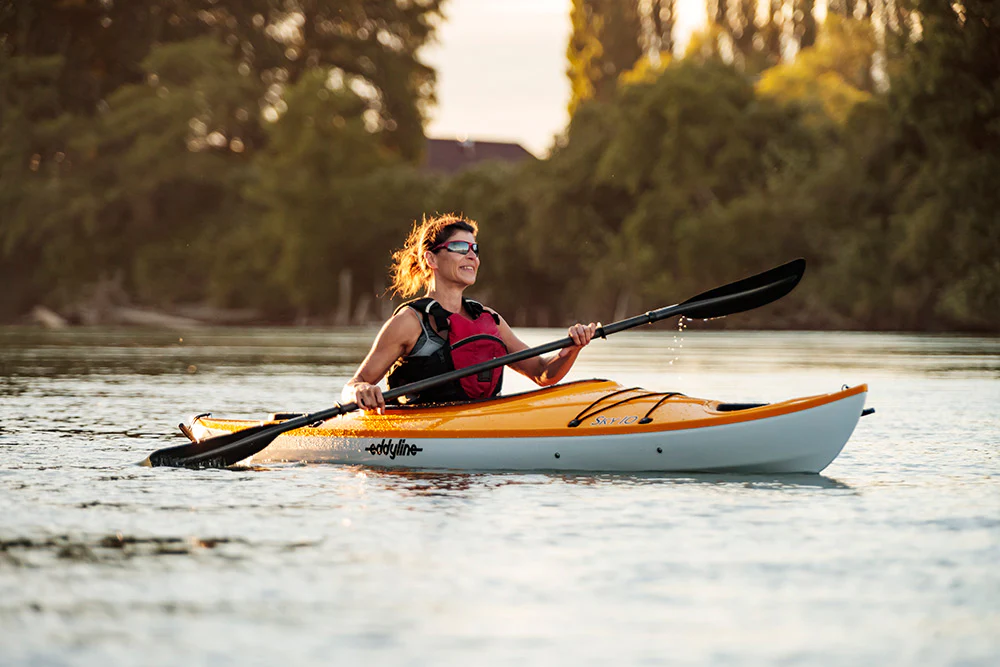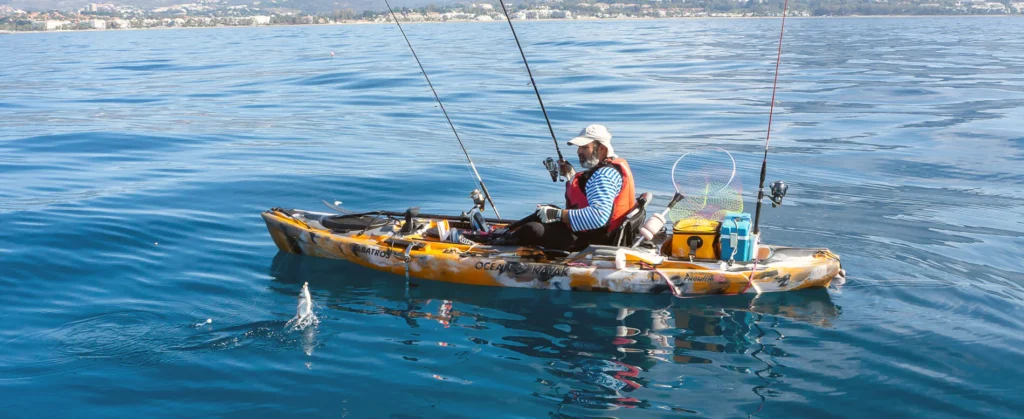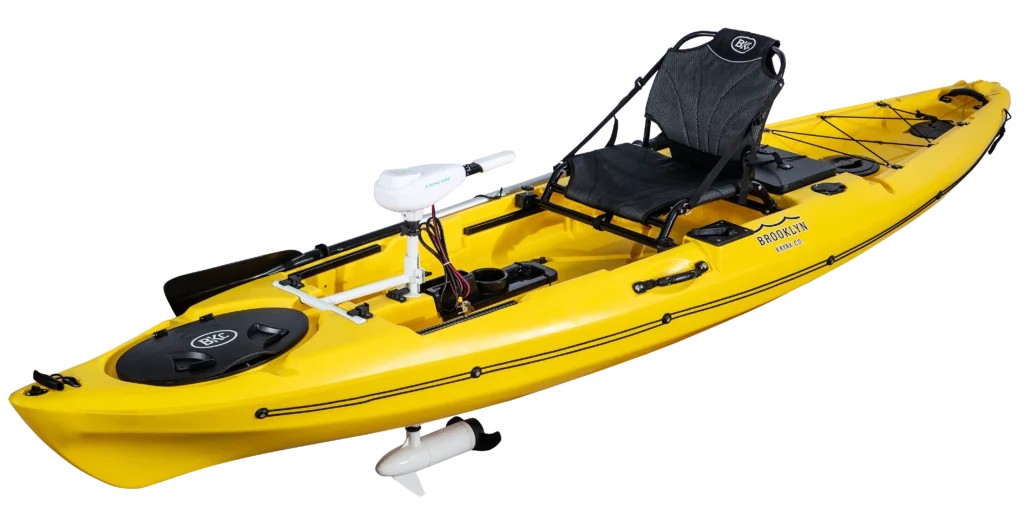Are you planning a kayaking adventure but worried about your weight? Well, fret not! In this blog post, we will dive deep into the world of kayak weight limits and answer the burning question: should you really care? Whether you’re a seasoned paddler or a newbie, understanding the importance of kayak weight limits can make or break your experience on the water. So, get ready to paddle through this insightful journey and discover the impact of exceeding those limits, factors influencing them, and how to optimize your kayak’s performance. Buckle up, folks, because we’re about to embark on a buoyant adventure!
Understanding Kayak Weight Limits
Embarking on a kayaking adventure requires more than just an adventurous spirit and a love for water. It demands an understanding of a key, yet often overlooked aspect – the kayak weight limit. This is not just a random number but a scientifically derived value that indicates the maximum load a kayak can safely carry without compromising its stability or buoyancy.
Manufacturers use different terminology to express this concept, including life load limit, weight rating, maximum weight limit, and maximum capacity. Although named differently, they all serve the same purpose – ensuring your safety and optimal performance while paddling.
| Term | Description |
|---|---|
| Life Load Limit | Maximum weight including the paddler and gear that a kayak can support while remaining safe and functional |
| Weight Rating | Another term for the total weight a kayak can handle while maintaining optimal performance |
| Maximum Weight Limit | The absolute highest weight that a kayak can bear without risking capsizing |
| Maximum Capacity | Similar to the above, this refers to the total weight (paddler and gear) a kayak can safely carry |
Understanding these terms is crucial to kayak safety and performance. It ensures you don’t overload your vessel, keeping it stable, buoyant, and easy to maneuver on the water. Remember, the weight limit includes not only the paddler’s weight but also that of any gear you bring onboard. So, if a kayak’s weight limit is 300 pounds, it’s designed to carry a combined weight of the paddler and his gear, up to 300 pounds.
As we delve deeper into the subject of kayak weight limits, you’ll discover how exceeding these limits can impact your experience and safety on the water. It’s not merely a number, but a guide to your journey on the waves, helping you to paddle with confidence and peace of mind.
Why Kayak Weight Limits Matter
Envision yourself preparing for a serene and refreshing day on the water. You have your kayak, your gear, and a heart full of anticipation. However, have you paused to consider the weight limit of your kayak? Understanding this crucial aspect can make a world of difference in your kayaking experience.
Consider a kayak with a weight limit of 300 pounds. This doesn’t imply that it’s solely designed for a paddler who weighs 300 pounds. Instead, it signifies that the kayak is engineered to sustain a total weight of 300 pounds, which includes the paddler and their gear. This weight limit is the kayak’s safety threshold, beyond which its performance could be compromised.
Let’s dive a bit deeper into this. Exceeding the weight limit of a kayak doesn’t necessarily mean it will sink. However, it can severely impact the kayak’s maneuverability and stability. A overloaded kayak will sit lower in the water, making it more susceptible to waves, harder to paddle, and less responsive to steering. It’s akin to driving an overloaded truck; it’s possible, but far from ideal.
So, the weight limit of a kayak isn’t merely about preventing your vessel from sinking. It’s about ensuring a safe, effortless, and enjoyable paddling experience. It’s about maintaining the kayak’s stability, ease of steering, and overall performance.
Therefore, when we talk about the weight limit of a kayak, it’s not just about you, the paddler. It’s also about the gear you bring along. The weight of your supplies, whether it’s safety equipment, fishing gear, or camping essentials, all add to the total weight your kayak must carry. This is a crucial consideration, especially for those embarking on multi-day adventures or fishing trips.
In conclusion, understanding your kayak’s weight limit is more than a safety precaution. It’s an integral part of planning your trip and ensuring an enjoyable and memorable kayaking experience.
The Impact of Exceeding Kayak Weight Limits
Imagine this: you’re geared up for an exciting day on the water, your kayak filled to the brim with all the essentials for a grand adventure. But as soon as you launch, you notice something seems off. Your usually nimble kayak feels sluggish and unresponsive. It sits lower in the water, and each paddle stroke feels like a battle against the current. This, my fellow kayaking enthusiasts, is the real-life scenario of what happens when you exceed your kayak’s weight limit.
It’s a common misconception that the weight limit is just a suggestion, an arbitrary number that can be pushed and prodded without consequence. Yet, the truth of the matter is far from it. Exceeding the weight limit can have serious implications on your kayak’s performance and stability.
An overloaded kayak behaves much like an overburdened mule – it’s sluggish, unresponsive, and prone to stumbling. It sits lower in the water, making it harder to paddle and steer. The once smooth and effortless glide becomes a laborious slog as the kayak struggles to cut through the water.
Poor stability is another consequence of an overloaded kayak. It doesn’t take much for the kayak to tip over when it’s struggling under excess weight. A sudden shift in weight, a strong gust of wind, or a particularly vigorous paddle stroke can send you and your gear tumbling into the water.
The simple act of exceeding the weight limit can transform a fun, enjoyable day on the water into a challenging and potentially dangerous experience.
Furthermore, exceeding the weight limit can result in significantly decreased maneuverability and tracking. Your kayak becomes less responsive, making it harder to navigate through narrow passages or around obstacles. It’s like trying to steer a fully loaded cargo ship – it just doesn’t respond as quickly or accurately as it should.
Lastly, an overloaded kayak is more prone to capsizing, especially in turbulent waters. The lower the kayak sits in the water, the more unstable it becomes, increasing the risk of a capsizing incident.
So remember, the weight limit isn’t just a number – it’s a vital guideline designed to ensure safety and optimal performance. Disregarding it not only diminishes the joy of kayaking but also puts you at risk. So before embarking on your next kayaking adventure, make sure to consider the weight of all your gear and supplies, and stay within the designated weight limit.
Factors Influencing Kayak Weight Limit
As we venture further into the fascinating world of kayaking, one aspect that stands out is the weight limit of a kayak. This seemingly arbitrary number is more than just a guideline—it’s a vital factor in your kayaking experience, shaping not only safety but also performance, stability, and maneuverability. But what influences this weight limit? It’s a blend of the kayak’s dimensions and volume, a mysterious concoction that manufacturers mix in their own unique ways.
At the heart of this equation are the three key parameters: length, width, and volume of the kayak. Let’s dive a little deeper into each of these.
Length
The length of a kayak is like the marathon runner’s stride—longer ones can cover more water with less effort, accommodating more weight. Longer kayaks usually have higher weight limits, making them ideal for multi-day trips carrying considerable gear.
Width
The width—or beam—of a kayak is its stability foundation, much like a tightrope walker’s balancing pole. Wider kayaks offer more stability and, in turn, higher weight limits. However, this comes at the cost of speed—a delicate balance to strike.
Volume
The volume of a kayak is its unsung hero, reflecting the boat’s overall capacity. A kayak with higher volume can support more weight, including the paddler and gear. However, a kayak should not be overloaded, as this can compromise stability and performance.
These three factors are the building blocks that kayak manufacturers use to determine the weight limit of a kayak. However, it’s important to highlight that there isn’t a universally accepted method or industry standard for this process. Just like chefs have their unique recipes, kayak manufacturers have their own methodologies for determining weight limits.
Read more: Bungee Jumping in Utah: Uncover the Best Places and Operators for an Epic Adrenaline Rush
While these factors give us a broad understanding of how weight limits are established, they are just part of the story. Up next, we will explore the difference between performance weight limit and maximum weight limit—a distinction that can greatly impact your kayaking experience.
Performance Weight Limit Vs. Maximum Weight Limit: The Crucial Difference
Picture this: you’re perched on the edge of a serene lake, the sun’s rays dappling the water’s surface. You’re ready to embark on an invigorating kayaking adventure. You have your gear ready, and you know your kayak’s specified weight limit. But, have you considered the difference between the performance weight limit and the maximum weight limit?
Understanding this difference is like knowing the distance your car can travel efficiently on a tank of gas versus pushing it to the last drop. It may go further, but the ride won’t be as smooth, and you might risk damaging your car. Similarly, while your kayak might float with a load close to its maximum weight limit, it won’t perform optimally. To ensure a smooth, safe, and enjoyable ride, it helps to stay within the performance weight limit.
The performance weight limit tends to be about 30-35% less than the manufacturer’s specified maximum weight limit. This is the weight at which your kayak will glide smoothly and respond promptly to your movements.
Now, how do you calculate the performance weight limit? Picture yourself as a math whiz, scribbling an equation on a chalkboard: Kayak weight limit x 0.7 = performance weight limit. This equation represents a 30% reduction from the maximum limit. To make it more tangible, let’s explore an example.
Suppose you’ve figured out that, with your body weight and gear combined, you hit a total of 200 pounds. Using the equation, you’d find that the suitable kayak weight limit would be approximately 285 pounds. In other words, your performance weight limit (200 pounds) divided by 0.7 equals the kayak weight limit (approximately 285 pounds).
So, as you prepare for your next kayaking adventure, remember the importance of understanding the difference between these weight limits. Keeping your load within the performance weight limit will ensure a smoother, safer, and more enjoyable ride, allowing you to fully embrace the tranquility or adventure that awaits you on the water.
Optimizing Kayak Performance
Imagine being on a pristine lake, smoothly gliding across the surface with each stroke of your paddle. The sun is kissing your skin, the wind is playing with your hair, and all around you, the world is in its unspoiled beauty. This idyllic kayaking experience, however, can be significantly marred if your kayak is too heavily loaded. But how do we ensure we have the perfect balance?
Here’s an interesting fact: utilizing just 50% of your kayak’s weight limit can markedly enhance both performance and efficiency. It’s akin to running with a light backpack instead of carrying a hefty suitcase. Your kayak becomes more responsive, easier to maneuver, and quicker to paddle. Not to mention, this reduced load helps keep your kayak dry, as less water will sneak in through the scuppers.
But let’s face reality – we’re adventurers at heart, aren’t we? We don’t just carry ourselves; we carry our dreams, our curiosity, and a whole lot of gear to navigate them. The 50% weight limit might seem like a challenge. But don’t worry, there’s a solution.
For an optimal balance between performance and practicality, it’s advisable to limit your load to 70% of your kayak’s weight limit. This percentage offers a winning blend of agility and capacity, ensuring your kayak adventure is as smooth and pleasant as possible.
In a nutshell, while it’s important to know the maximum weight limit of your kayak, what truly matters for an enjoyable kayaking experience is understanding and sticking to the performance weight limit. So, whether you’re a seasoned paddler or a kayaking newbie, keep these percentages in mind: 70% for a balance of performance and capacity, and 50% for ultimate performance and dryness.
Remember, a well-balanced kayak isn’t just about safety and efficiency – it’s about making the most of your adventure on the water.
Unraveling the Weight Limits of Different Kayak Types
Just as every kayaker has a unique paddling style and preference, so do kayaks come in a variety of shapes and sizes, each catering to a specific need. In the captivating world of kayaking, the type of kayak you choose and its corresponding weight limit plays a pivotal role in your paddling performance and overall adventure experience.
Imagine this: Your kayak is your trusted companion, your tireless steed. It should carry you and your gear confidently, without wavering or sinking. But how can you ensure this? It all comes down to understanding the weight limit of your kayak and respecting it. Let’s delve into the specifics of different types of kayaks and their weight limits.
Touring Kayaks
If you’re the kind of adventurer who yearns to paddle across vast water bodies, exploring the hidden corners of nature on multi-day trips, touring kayaks are your go-to. These long-distance champions are built for endurance and have a generous maximum weight capacity of around 350 pounds. This allows you to pack essential gear and provisions without compromising on performance or safety.
Recreational Kayaks

recreational kayak
For the casual paddlers who relish tranquility and leisurely floats on slow-moving rivers or calm lakes, recreational kayaks are a perfect match. Their weight limits typically hover between 250 to 300 pounds, providing a comfortable and stable ride for a laid-back day on the water.
Tandem Kayaks

tandem kayaks
Nothing beats the joy of sharing a paddling journey with a friend or loved one. Tandem kayaks, crafted for two, offer the combined strength and camaraderie of duo paddling. With a hefty weight limit ranging from 500 to 600 pounds, these kayaks are designed to accommodate two paddlers and their gear comfortably.
Fishing Kayaks

fishing kayak
For the angler who marries the thrill of fishing with the serenity of kayaking, fishing kayaks are a dream come true. These specialized vessels offer ample space for fishing equipment and the catch of the day. With weight limits varying between 400 to 550 pounds, they ensure a stable, secure, and rewarding fishing experience.
In conclusion, understanding the weight limits of different types of kayaks is the key to optimizing your paddling performance and ensuring safety. Whether you’re touring, fishing, or simply enjoying a leisurely paddle, the right kayak with an appropriate weight limit can make all the difference in your kayaking adventure.
Inflatable Kayaks and Their Weight Limits
Imagine a hiking trip on a beautiful, sunny day. You’re walking through lush greenery, the sun warming your skin, the birds chirping melodiously in the background. Suddenly, you come across a serene lake, its crystal-clear waters beckoning you. You reach for your backpack, and out comes your trusty inflatable kayak, your gateway to a delightful water adventure. But before you set sail, you ask yourself – “How much weight can my inflatable kayak hold?”
Over the years, inflatable kayaks have undergone massive improvements. Once dismissed as mere pool toys, they’ve evolved into reliable vessels, capable of competing with their hard-shell counterparts in terms of durability, performance, and most importantly, weight capacity.
Check out: Bungee Jumping in South Carolina: Where Can You Get Your Adrenaline Fix?
The weight capacity of an inflatable kayak is surprisingly high, often ranging from 400 to 750 pounds. This impressive load capacity makes them a preferred choice for many adventurers, whether solo paddlers, couples seeking a romantic escapade, or even a family of three out for a fun day on the water.
However, as tempting as it may be to load up your kayak with everything but the kitchen sink, it’s crucial to understand that the performance of your kayak will begin to decline as you approach its maximum weight limit. Like a car overloaded with passengers and luggage, an overly heavy kayak can become sluggish and unresponsive, potentially compromising your safety and enjoyment.
It’s also worth noting that there is no way to increase the weight capacity of a kayak. The specifications set by the manufacturer are based on factors such as the kayak’s length, width, and design, and cannot be modified. So, if you’re planning a heavy load for your day on the water, choosing a kayak with a higher weight limit from the outset is a wise move.
Understanding the weight limits of your inflatable kayak and adhering to them not only ensures an optimal kayaking experience but also guarantees your safety. So, before you embark on your next kayaking adventure, make sure to check your gear, supplies, and most importantly, your inflatable kayak’s weight limit.
Improving Kayak Buoyancy and Stability

kayak
Imagine you’re packing for your next grand kayaking adventure. You’ve got all your gear sorted out – your fishing equipment, safety gear, waterproof camera, packed lunch, and maybe even your furry friend wants to tag along. But as you start to load everything onto your kayak, you notice it’s sitting lower in the water than it should. You recall the importance of the kayak’s weight limit, but it’s too late now. The kayak is already at its maximum capacity, and yet, there’s still more to load. What do you do?
Here’s where outriggers or floats come into play. These handy accessories are like lifesavers, literally. They can greatly enhance your kayak’s buoyancy and stability, especially when you’re carrying a lot of gear.
Think of outriggers as extra pontoons or arms extending from the sides of your kayak. They provide additional buoyancy, helping your kayak stay afloat even when it’s loaded near or at its weight limit. This increase in buoyancy significantly reduces the risk of capsizing, ensuring you and your gear stay dry and safe.
Similarly, floats can be attached to your kayak to further boost its buoyancy. They operate on the same principle as outriggers, using their volume to displace water and help keep your kayak afloat. They’re usually inflatable, making them easy to transport and attach when needed.
However, it’s crucial to remember that while outriggers and floats offer increased stability and buoyancy, they may sacrifice maneuverability. Adding these accessories can make your kayak wider and heavier, making it harder to steer and navigate, especially in tight spots or fast currents.
So, even as you marvel at the idea of converting your vessel into a seemingly unsinkable one, remember this trade-off. Consider the conditions you’ll be kayaking in, your skill level, and the amount of gear you need to carry before deciding to use outriggers or floats. Striking the right balance between buoyancy, stability, and maneuverability is key to a successful and enjoyable kayaking experience.
Ultimately, understanding and respecting the weight limits of different types of kayaks and knowing how to enhance buoyancy and stability can significantly improve your overall kayaking experience. It’s not just about avoiding an inconvenient, potentially dangerous situation; it’s about making the most of your adventure on the water.
Conclusion: The Weight of Your Decision
Think of it this way: imagine you’re planning a road trip. You wouldn’t just pile your luggage into the car without considering the vehicle’s weight limit, would you? A car’s suspension system is designed to handle a certain amount of weight. If you exceed that limit, your car’s performance is compromised, and your safety is at risk. The same principle applies to the humble kayak.
Choosing a kayak is not just about selecting a model with a beautiful design or vibrant color. It’s like embarking on a journey where the weight limit becomes your trusted map and compass, guiding you to choose the right vessel for your needs. It might seem like a minute detail, but it has a profound effect on your overall kayaking experience.
Why, you ask? Because the weight limit of a kayak is the lifeline that affects its performance and safety. It’s a silent influencer that plays a pivotal role in how your kayak behaves on the water. Overload it, and you’ll find your kayak sitting lower in the water than usual, becoming sluggish and unresponsive. Underestimate it, and you risk compromising your safety.
“The weight limit of a kayak is not just a number, it’s a guide to optimal performance and safety.”
Whether you’re a seasoned kayaker or a novice exploring the waterways for the first time, understanding and respecting the weight limit of your kayak can make all the difference in your adventure. It’s not just about staying afloat; it’s about ensuring that your kayak performs at its best, offering you a smooth, safe, and enjoyable ride.
So the next time you go shopping for a kayak, remember to take the weight limit seriously. It might just be the difference between a memorable kayaking experience and a lesson learned the hard way.
The weight limit of a kayak refers to how much weight it can hold and remain afloat, including the weight of the paddler and any gear they bring onboard.
It is important to pay attention to the weight limit when buying a kayak as it can affect the performance and overall kayaking experience. Exceeding the weight limit can negatively impact the kayak’s performance and stability.
Exceeding the weight limit of a kayak can have consequences. It causes the kayak to sit lower in the water, making it difficult to paddle. Overloaded kayaks also have poor stability due to poor weight distribution, increasing the chances of capsizing. Maneuverability and tracking are significantly decreased in overloaded kayaks.
The weight limit of a kayak affects its performance and safety. As a kayak approaches its weight limit, its performance declines. It is important to take the weight limit seriously to ensure a better experience on the water and to maintain the kayak’s stability and maneuverability.

